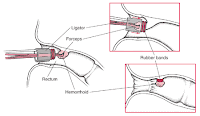| 6:02 AM |
Hemmroid Banding |
 Hemmroid banding is a procedure recommended for those whose hemmroids are located in the rectum or the anus and for those who have sever bleeding, pain or if the hemmroid contains a blood clot. But this banding procedure is not for those whose prolapsed hemmroid hangs on the outside of the body.
Hemmroid banding is a procedure recommended for those whose hemmroids are located in the rectum or the anus and for those who have sever bleeding, pain or if the hemmroid contains a blood clot. But this banding procedure is not for those whose prolapsed hemmroid hangs on the outside of the body.Hemmroid banding is used to treat painful, swollen hemmroids. And more than one hemmroid can be banded at the same time. This hemmroid banding is most often performed for the following reasons:
- • Severely bleeding hemmroids
- • Severely painful hemmroids
- • Hemmroid containing a blood clot (called thrombosed hemmroid)
- • Hemmroids that protrude through the anus (called prolapsed hemmroids)
Hemmroid banding is done using local anesthesia, and you are considered an in and out patient because it is one of those same day surgery procedures; A procedure that involves a doctor inserting an instrument with a light and lens, called an anoscope, through the anus, which is held in position by an assistant. This instrument will allow the doctor to locate and see the hemmroid problem. Once the hemmroid is located, the doctor uses a special banding tool to place a small rubber band around the hemmroid. And this procedure will cause the hemmroid to shrink because this hemmroid banding cuts off the blood supply to the hemmroid. The rubber band stays in place for 1-2 weeks until the hemmroid falls off.
It usually appears to be that the only way to be rid of hemmroids is to go through more pain and suffering by procedures that claim to eliminate the pain, bleeding, and swelling once and for all; snip, clip and tie and then your hemmroid issue will vanish forever. But it should not be at all cases. There are a lot of severe hemmroid condition that can only be treated with natural home remedies but because other hemmroid condition does not respond to natural treatments that’s why hemmroid banding is recommended even it cause you pain.
The procedure of hemmroid banding is another method that will eliminate a hemmroid, but not without leaving you with a painful recovery period. As you can see, anything connected to hemmroid relief comes with a certain amount of suffering before and after; at least when you use the conventional methods of destroying the embarrassing problem.
However, do not think that since the hemmroid is gone that your worries are over; you may find yourself back at the doctor's office for the same hemmroid issue, simply because the problem can return. All that pain and suffering repeated, letting you know that the procedure is just a temporary fix.
Take not that with this particular hemmroid banding procedure, there is automatic discomfort during and after the banding treatment. This is a relatively quick procedure, but the length of time depends on how many hemmroids need treatment.
Patients often report some discomfort during and after this hemmroid banding procedure. If you feel sharp or severe pain, tell the doctor immediately. Mild pain medication helps manage discomfort during recovery. These possible complications includes:
- • Infection
- • Excessive bleeding
- • Allergic or other adverse reaction to the local anesthetic (if used)
- • Difficulty urinating
- • Difficulty passing stool due to scar tissue
- • Swelling and pain from remaining hemmroids
- • Recurrence of hemmroids
With hemmroid banding, after everything is over and done with, your doctor will tell you to avoid straining, bearing down when using the bathroom and holding your breath during your bowel movement to avoid complications and to promote fast recovery. Here are some postoperative care after your hemmroid banding procedure:
- • Expect some bleeding and discomfort.
- • Take sitz baths as recommended. Sitz baths will help relieve discomfort and clean the area. For a sitz bath, sit in warm water for 10-15 minutes. Pat the area dry, do not wipe or rub vigorously. You may be advised to take a sitz bath every four hours and after every bowel movement. Devices are available to place on top of the toilet to make this process easier.
- • For a few days, you may have difficulty controlling passage of gas and bowel movements.
- • Use a stool softener, exercise, drink plenty of fluids, and eat plenty of high-fiber foods (fruits, vegetables, beans, and whole grains) to prevent constipation and straining during bowel movements.
- • Move your bowels as soon as you feel the urge.
- • Do not sit on the toilet for long periods of time.
- • Apply hemmroid creams or ointments as directed by your doctor.
- • Avoid heavy lifting for two or three weeks.
Also do not hesitate to call your doctor if any of the following occurs after your hemmroid banding:
- • Passing large amounts of blood
- • Pain becomes more severe
- • An aching feeling develops in the perineal area, between the rectum and the genitals
- • Signs of infection, including fever and chills
- • Constipation or difficulty urinating
Lastly, with all the hardship you encounter during and after your hemmroid banding, still many people may continue to develop new hemmroids after the banding procedure. What is better advise is really to treat your hemmorhoid as soon as possible before its too late. Not only with hemmroid banding but also with other surgical treatment . All hemmroid surgical procedure will not give you 100% completely healed condition without recur. Therefore, at first glance of hemmroid symptoms, immediately seek for doctors advise. Yet, still prevention is better than cure.
0 comments:
Post a Comment